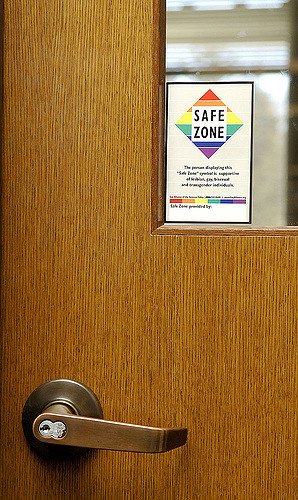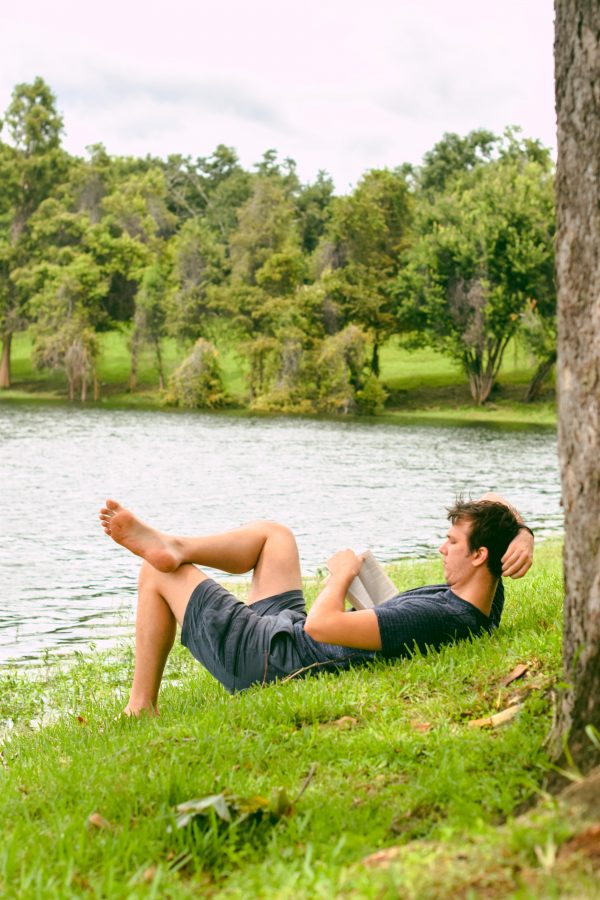I think safe spaces are always an important topic to talk about. However, I think it is a timely topic with the new president who took office. In this piece, I’ll be talking about what a safe space is, the history behind them, and people’s different opinions on them.
Definitions
So what is a safe space? Well, I’m glad you asked. There are a couple of variations of definitions:
- Safe space- (referred to Safe Zone- where safe zone stickers are present) “that they will challenge anti-LGBTQ language and harassment when it occurs; they are open to the discussion of LGBTQ issues in context of classwork or just in conversation; they might be a safe person to whom an LGBTQ student could “come out”; and in some cases, that the educator is lesbian, gay, bisexual, transgender, queer, or questioning” (Slater 7).
- Spaces for those who are silent and do not see themselves within themselves within the dominant discourses, particularly students who are queer and questioning…promoting understand and respect for difference (Bloomfield 50)
- Places where students who are struggling with their sexual identity…that they could talk to that professor without fear (Cabe).
- “Intended to give people who might find comments “troubling” or “triggering,” a place to recuperate” (Shulevitz).
- safe spaces are innocuous gatherings of like-minded people who agree to refrain from ridicule, criticism or what they term microaggressions — subtle displays of racial or sexual bias — so that everyone can relax enough to explore the nuances of, say, a fluid gender identity” (Shulevitz).
- “Safe spaces aren’t some club where nasty liberals sit around and bash cis straight white people. That’s what coffee houses and drama clubs are for. In my experience, they’re basically just small environments where students could go to not casually have “n****r” or “f****t” slung in their direction” (Shulevitz).
- “Safe spaces are places or communities – either online or off – where bigotry and oppressive views are not tolerated. They are controlled environments (insofar as they can be) in which people can discuss certain issues and support one another. Usually, safe spaces will focus on specific issues, like sexism, racism, or transantagonism” (Ferguson).
History of Safe Spaces
As I usually do, I think it’s important to understand history, especially because I feel safe spaces are something some people think is a new idea. However, that is not the case. Safe spaces date back to the mid-60s. In the book Mapping Gay L.A., author Moira Kennedy explains that a safe place was where people could find practical resistance to political and social repression. It started being used to during the women’s movement when safety began to mean distance from men and patriarchal thought and was used to describe “consciousness raising” groups…a space created by the community together of women searching for community” (Harris).
As seen in the definitions above, I think it is often seen within the LGBTQ Community, but also in marginalized groups of folks who come together for community.
About Safe Spaces
- Safe spaces are different than safe space training. Safe spaces are referring to physical space, while safe space training is typically a form of allyship or educational training.
- Safe spaces are often talked about on college campuses or schools.
- People also find safe spaces on the Internet
- Some people really focus on safe spaces being about places to debate topics. While I think this may be the case, I think there are different types of spaces.
- Sometimes safe spaces are only for certain groups of folks, often marginalized groups who need them. This is not to exclude or discriminate, it’s to form community of folks who want to be around like-minded folks who can probably relate.
- While we often equate safe spaces to the LGBTQ+ Community, especially because of the association with Safe Space Trainings, they can serve a purpose for any marginalized group.
- Safe Spaces come in many different forms. They may be spaces created for that purpose, someone’s office may become one, or they can be more public spaces.
Arguments Against Safe Spaces
There is a lot of debate about whether safe spaces should exist. In my opinion, I think the folks who think that do so because they just have never needed to seek them out. I feel the same about folks who don’t know what they are. Here are some of the arguments against safe spaces:
- They exclude unwanted people, facts, or ideas
- They don’t teach those using the space how to deal with opposing views and opinions
- They imply that non-space spaces in society are unsafe
- They are “echo chambers useless to discussion and to feminism” (Ferguson)
- They “create the false impression that we can insulate ourselves from those who hold different views” (Bloomberg)
- They make both professors and students loath to say anything that might hurt someone’s feelings (Shulevitz)
- From NYC Michael Bloomberg: “The whole purpose of college is to learn how to deal with difficult situations – not run away from them” (Bellware)
Conclusion
I am in full support of the creation of safe spaces. I use the word creation because after Orlando last year I think something a lot of folks recognizedthere is no such thing as a safe space. However, I don’t think the constant possibility of violence against marginalized communities should stop us from trying to protect folks. I hope this taught you a little bit about safe spaces. Feel free to check out the sources and additional resources below!
Sources
Bellware, K. (2016). Michael Bloomberg Slams ‘Safe Spaces’ And ‘Trigger Warnings’ In Speech to College Grads. The Huffington Post. http://www.huffingtonpost.com/entry/michael-bloomberg-commencement-speech_us_57264acee4b01a5ebde5ef85
Bloomberg. M. (2016). ‘Safe spaces’ defeat the whole point of college. New York Post. http://nypost.com/2016/05/03/safe-spaces-defeat-the-whole-point-of-college/
Cabe, I. (2016). This is What Safe Spaces and Trigger Warnings Actually Are. Cracked. http://www.cracked.com/blog/safe-spaces-arent-new-they-shouldnt-make-you-angry/
Ferguson, S. (2014). 6 Reasons Why We Need Safe Spaces. Everyday Feminism. http://everydayfeminism.com/2014/08/we-need-safe-spaces/
Harris, M. (2015). What’s a ‘Safe Space’? A look at the phrase’s 50-year history. Fusion. http://fusion.net/story/231089/safe-space-history/
Shulevitz, J. (2015). Hiding From Scary Ideas. The New York Times. p. 1. https://www.nytimes.com/2015/03/22/opinion/sunday/judith-shulevitz-hiding-from-scary-ideas.html?ref=oembed
Slater, T. (2016). Unsafe space : The crisis of free speech on campus. London: Palgrave Macmillan.
Additional Resources:
Bloomfield, Veronica E., and Marni E. Fisher. 2016. LGBTQ Voices in Education: Changing the Culture of Schooling. New York, NY: Routledge, Taylor & Francis Group.
Sadowski, M. (2016). Safe is not enough: Better schools for LGBTQ students (Youth Development and Education series; Youth Development and Education series). Cambridge, Massachusetts: Harvard Educatioess.
Originally published on: https://coloritqueer.com/






